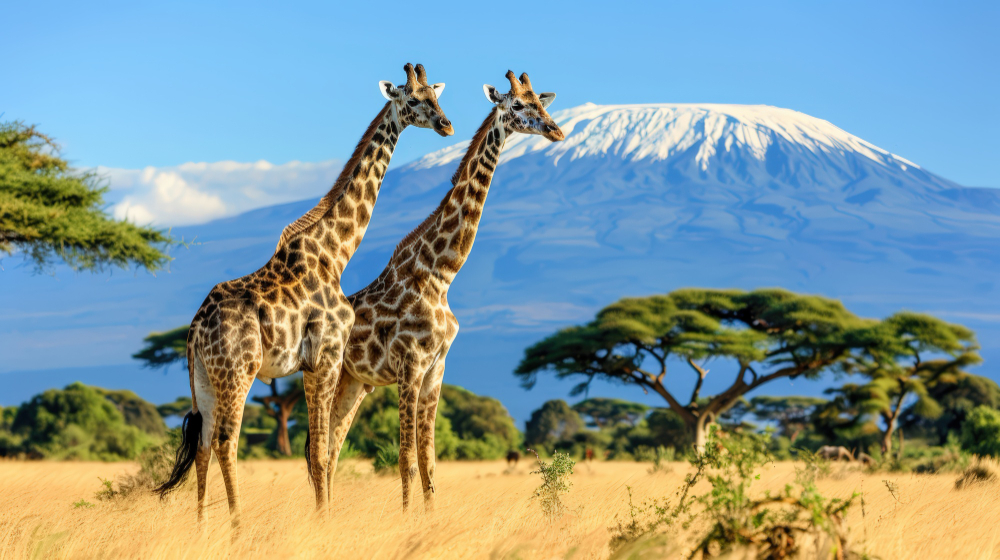Embarking on a safari in Kenya and Tanzania is a dream for many travelers. With breathtaking landscapes, diverse wildlife, and rich cultures, these countries offer an unforgettable experience. This blog outlines a well-optimized 10-day itinerary, including key highlights, travel tips, and estimated costs to help you plan your adventure.
Day 1: Arrival in Nairobi, Kenya
Your journey begins in Nairobi, the vibrant capital of Kenya. Upon arrival at Jomo Kenyatta International Airport, you’ll be greeted by your tour operator who will assist you with your transfer to the hotel. After settling in, take the afternoon to explore Nairobi. Visit the David Sheldrick Wildlife Trust, where you can learn about elephant conservation and even adopt a baby elephant.
Cost Tip: Entry fees for the wildlife trust are approximately $7.
Day 2: Nairobi to Maasai Mara National Reserve
After breakfast, embark on a scenic drive to the Maasai Mara National Reserve, one of Africa’s most famous wildlife parks. The journey takes around 5-6 hours, but the stunning landscapes make it worthwhile. Upon arrival, check into your lodge and enjoy a hearty lunch.
In the afternoon, head out for your first game drive. The Maasai Mara is home to the Big Five (lion, leopard, elephant, buffalo, and rhinoceros), and you’ll have the chance to see these majestic animals in their natural habitat.
Cost Tip: Expect to pay around $80 for park entry fees.
Day 3: Full Day in Maasai Mara
Spend a full day exploring the Maasai Mara. Start your morning with an early game drive to catch the wildlife at their most active. Afterward, return to your lodge for breakfast.
In the afternoon, you can choose to visit a local Maasai village to immerse yourself in the culture and traditions of the Maasai people. This experience often includes traditional dances and the opportunity to buy handmade crafts.
Cost Tip: Village visits typically cost around $20 per person.
Day 4: Maasai Mara to Serengeti National Park, Tanzania
On Day 4, you will cross the border into Tanzania and head to the Serengeti National Park. After breakfast, take a short flight or a scenic drive through the picturesque landscapes. Upon arrival in the Serengeti, check into your lodge and enjoy lunch.
In the afternoon, embark on another game drive. The Serengeti is renowned for its vast savannahs and incredible wildlife migrations, making it a must-visit destination.
Cost Tip: Expect to pay around $70 for park entry fees.
Day 5: Full Day in Serengeti
Dedicate this day to exploring the Serengeti. You can opt for a sunrise hot air balloon ride, offering a unique perspective of the park from above, followed by a champagne breakfast in the bush.
Later, continue your game drives, searching for lions, cheetahs, and other wildlife. The Serengeti is also known for its stunning sunsets, so be sure to capture the breathtaking views.
Cost Tip: Hot air balloon rides typically cost around $500 per person.
Day 6: Serengeti to Ngorongoro Crater
After breakfast, depart for the Ngorongoro Crater, a UNESCO World Heritage site. The drive takes approximately 3-4 hours. Once you arrive, descend into the crater for a half-day game drive. The Ngorongoro Crater is famous for its high concentration of wildlife, including the endangered black rhino.
Enjoy a picnic lunch in the crater before returning to your lodge for the night.
Cost Tip: Ngorongoro Crater fees are about $70 per person.
Day 7: Ngorongoro to Lake Manyara National Park
On Day 7, head to Lake Manyara National Park, known for its diverse ecosystems and tree-climbing lions. The drive takes about 2 hours. After a quick lunch, embark on an afternoon game drive.
Lake Manyara is also a birdwatcher’s paradise, with over 400 species recorded. Look out for flamingos, pelicans, and the vibrant lilac-breasted roller.
Cost Tip: Park entry fees are around $45.
Day 8: Lake Manyara to Arusha
After breakfast, drive to Arusha, the gateway to Tanzania’s northern parks. Spend the day exploring the town, visiting local markets, and enjoying the vibrant culture.
Consider visiting the Cultural Heritage Centre, where you can learn about Tanzania’s history and art.
Cost Tip: Entry to the Cultural Heritage Centre is free, but purchases are encouraged.
Day 9: Arusha to Nairobi
On Day 9, return to Nairobi. You can opt for a flight or a scenic drive back, which takes about 5 hours. Upon arrival, check into your hotel and relax.
In the evening, consider dining at a local restaurant to savor traditional Kenyan cuisine, such as nyama choma (grilled meat) and ugali (maize porridge).
Cost Tip: A meal at a local restaurant can range from $10 to $30.
Day 10: Departure
On your final day, depending on your flight schedule, you may have some free time for last-minute shopping or sightseeing. Visit the Giraffe Centre or the Karen Blixen Museum before heading to the airport for your departure.
Cost Tip: Allow for around $50 for any last-minute expenses.
Estimated Costs
Here’s a breakdown of estimated costs for your 10-day safari:
Accommodation: $100 – $300 per night
Meals: $30 – $100 per day
Park Entry Fees: $400 – $500 total
Activities (hot air balloon, village visits): $100 – $600 total
Transportation (flights, transfers): $300 – $600 total
Overall, budget approximately $3,000 – $6,000 per person for this unforgettable safari experience, depending on your preferences for accommodation and activities.
Conclusion
A 10-day safari in Kenya and Tanzania is a remarkable way to explore the beauty and diversity of East Africa. With this itinerary, you’ll experience the best of both countries, from the iconic Maasai Mara to the stunning Serengeti and Ngorongoro Crater. Prepare for an adventure of a lifetime filled with incredible wildlife encounters and cultural experiences. Happy travels!

